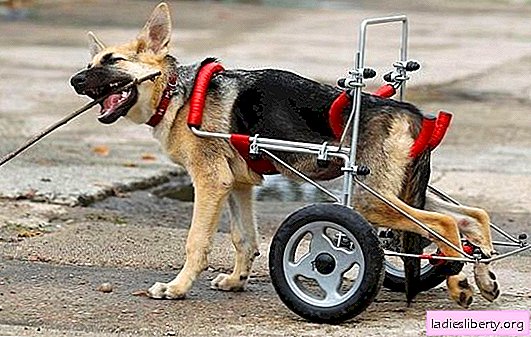
Many say - “heals like a dog” and are very mistaken, because these cute animals, like people, are not protected from diseases, including those associated with the musculoskeletal system.
There are situations when the dog's front or hind legs begin to fail. Why this happens and what affects the appearance of this ailment can be found in this article.
The dog's paws fail: what symptoms should I look for?
A similar problem can appear suddenly and with vivid symptoms, and can progress for a long time without manifesting itself in any way. In the latter case, even the most caring dog owner may not notice something was wrong. The fact is that their visibility directly depends only on the factors of the formation of the disease.
The main symptom of the development of the disease is the appearance of pain, which does not always have a pronounced character. At the first stage of disease progression, the dog may experience occasional involuntary movement of the pelvis, more reminiscent of "lazy wagging."
Such signs are easy to see during the walk. Often, pain occurs after outdoor activities (games) or physical exertion. In more severe cases, the dog has a lack of coordination or an uncontrolled fall.
When a pet tries to rise on its paws and does not succeed, it begins to panic and, naturally, suffer from a misunderstanding of what is happening. Often, an animal resting after active games begins to move normally. However, sometimes the dog's paws fail for a sufficiently long time.
The whole period of the disease is disturbed by pain and weakness in the hind legs, so it is difficult for her to stand up and stand. Also an important sign of the problem is a change in the dog’s gait, during which his legs are braided.
However, the most terrible symptom is the complete lack of sensitivity of the paws, which leads to the inability to move them. The presence of such symptoms indicates the development of paralysis or paresis, which require qualified treatment.
Causes of dog paw failure
Diseases due to which this symptom appears do not always immediately manifest themselves, therefore it is difficult for a veterinarian to diagnose it. Often the period of their development is very long, and the owner of the pet, not knowing about the presence of an ailment, only aggravates the situation and accelerates its progression.
So, what diseases can cause a dog's paws to be motionless and can they be cured?
• Injury
The most common factor for this symptom, paresis and paralysis are simple injuries sustained during the jump, from a sufficiently high height, awkward movement, stretching or fracture when falling, rupture of a tendon, pinching of nerves, etc.
In order for the dog's paws to fail, a slight displacement of the bones, for example, the spinal disc, is quite enough. Also, the dog often has swelling due to damage in the region of the vertebral column, which begins to gradually compress and impair the functionality of the spinal cord.
This leads to impaired blood flow and rapid death of nerve cells. Over time, nerve impulses weaken and cannot reach, say, the “destination,” so the dog’s legs stop working.
Even after prolonged therapeutic treatment, the pet may again have this symptom. And the reason for this is not a competent and incomplete cure of the primary factor in its formation. Therefore, you must again contact a qualified veterinarian, but, of course, to another.
• Discopathy
The second name of the disease sounds like "herniated disc." It consists in the ailment of the spinal discs, namely, a modification of their substance, which eventually enters the spinal canal, and then into the area of the spinal cord. As a result, there is a strong compression of the spinal nerves. It is quite difficult to cure the ailment and often it makes the dog disabled.
• Dysplasia
Joint dysplasia is a difficult and treatable disease that begins to develop in four-month-old puppies. It is distinguished by pronounced symptoms: wagging of the hips, especially after heavy loads, limping after prolonged lying or sleeping, as well as the inability to run for a long time.
• Vertebral osteochondrosis
The disease is a kind of "continuation" of the previous ailment (discopathy). It represents the most difficult degree of destruction of the vertebrae, which is caused by a violation of cartilage mineralization. Excessive hardness of the organ is observed, leading to damage to the intervertebral ligaments and joints.
• Arthrosis and Arthritis
Very often, the causes of failure in a dog's paws are precisely these ailments. Arthrosis is a chronic type of disease, the distinguishing feature of which is the complete absence of inflammation. It is characterized by a change in cartilage with their further destruction.
While arthritis is a disease in the area of the bag of joints, accompanied by an inflammatory process. Reasons: lack of vitamins, minor injuries, malnutrition, an overabundance or lack of movement, hypothermia, aging, etc.
What to do if a dog's paws fail?
Naturally, the most effective way is preventive action. However, if the dog has a similar symptom, it is necessary to call a veterinarian and provide first aid, namely:
• immobilize the dog by tying it to the board;
• In no case should you give painkillers, because the cause of the symptom is not known.
The most important thing to do is to wait for a specialist who will conduct a thorough examination of the pet, determine the presence of sensitivity and pain in the spine, and also prescribe the necessary treatment and tests.
Depending on the severity of the disease, the veterinarian may insist not only on medical treatment, but also on surgical intervention. There are frequent cases when even the most hopelessly sick dogs after complex therapy got on their feet and became completely healthy.











